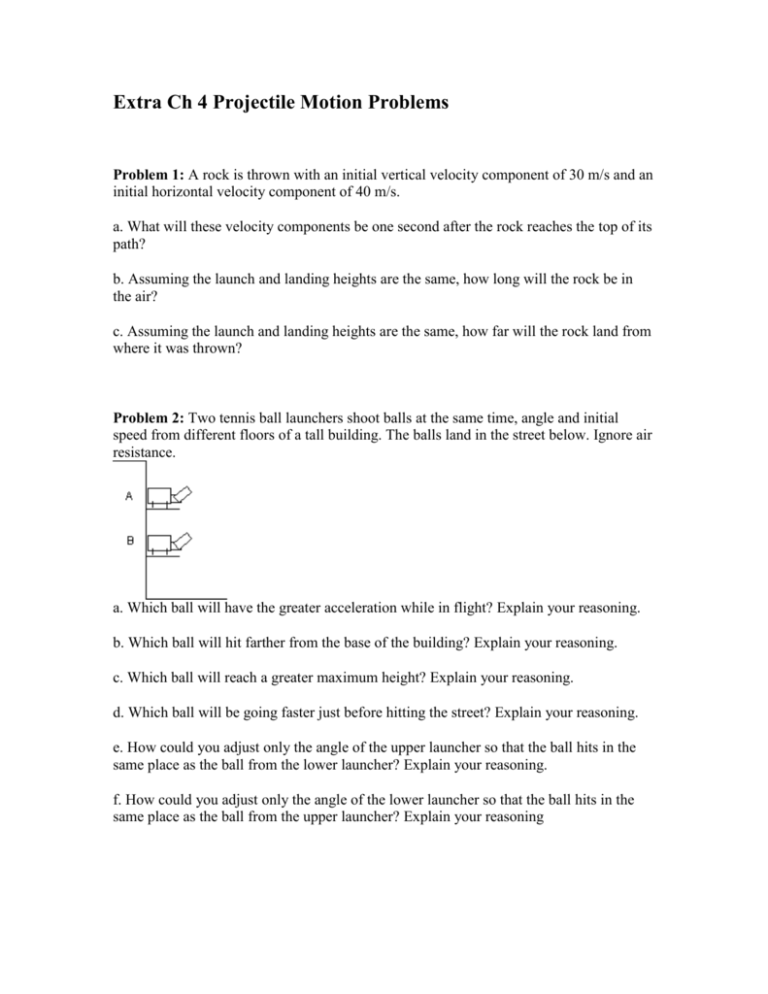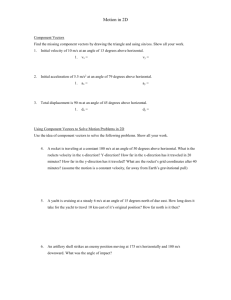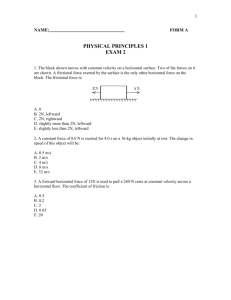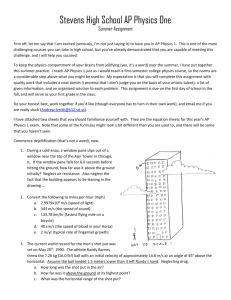Extra Ch 4 Projectile Motion and Relative Motion Problems
advertisement

Extra Ch 4 Projectile Motion Problems Problem 1: A rock is thrown with an initial vertical velocity component of 30 m/s and an initial horizontal velocity component of 40 m/s. a. What will these velocity components be one second after the rock reaches the top of its path? b. Assuming the launch and landing heights are the same, how long will the rock be in the air? c. Assuming the launch and landing heights are the same, how far will the rock land from where it was thrown? Problem 2: Two tennis ball launchers shoot balls at the same time, angle and initial speed from different floors of a tall building. The balls land in the street below. Ignore air resistance. a. Which ball will have the greater acceleration while in flight? Explain your reasoning. b. Which ball will hit farther from the base of the building? Explain your reasoning. c. Which ball will reach a greater maximum height? Explain your reasoning. d. Which ball will be going faster just before hitting the street? Explain your reasoning. e. How could you adjust only the angle of the upper launcher so that the ball hits in the same place as the ball from the lower launcher? Explain your reasoning. f. How could you adjust only the angle of the lower launcher so that the ball hits in the same place as the ball from the upper launcher? Explain your reasoning Problem 3: If a person can jump a horizontal distance of 3 m on Earth, how far could the person jump on the moon where the acceleration due to gravity is one-sixth of that on earth (1.7 m/s/s)? Problem 4: A brick is thrown upward from the top of a building at an angle of 25 degrees above the horizontal and with an initial speed of 15 m/s. If the brick is in the air for 3 seconds, how high is the building? (Draw a picture.) Problem 5: A daredevil tries to jump a canyon of width 10 m. To do so, he drives his motorcycle up an incline sloped at an angle of 15 degrees. What minimum speed is necessary to clear the canyon? Problem 1 Solution: A rock is thrown with an initial vertical velocity component of 30 m/s and an initial horizontal velocity component of 40 m/s. a. What will these velocity components be one second after the rock reaches the top of its path? The horizontal component of the velocity remains constant, 40 m/s. The vertical component of the velocity decreases by 10 m/s every second. So at the peak, the vertical component of the velocity is zero and one second later the vertical component of the velocity is -10 m/s. b. Assuming the launch and landing heights are the same, how long will the rock be in the air? Since the vertical component of the velocity decreases by 10 m/s every second, it will take 3 seconds for the vertical component of the velocity to slow from 30 m/s to 0 m/s, and another 3 seconds for the rock to accelerate from 0 m/s to -30 m/s. The total time in the air is 6 seconds. c. Assuming the launch and landing heights are the same, how far will the rock land from where it was thrown? Since the rock is in the air for six seconds and the rock moves horizontally 40 meters each second, the range for the rock is 6 s x 40 m/s = 240 m. Problem 2 Solution: Two tennis ball launchers shoot balls at the same time, angle and initial speed from different floors of a tall building. The balls land in the street below. Ignore air resistance. a. Which ball will have the greater acceleration while in flight? Explain your reasoning. Both have the same vertical acceleration since the net force is due to gravity alone (there is no horizontal acceleration.) Even if the balls were of different mass the acceleration would be the same. b. Which ball will hit farther from the base of the building? Explain your reasoning. Ball A will hit farther from the building since it has a higher starting position and will therefore be in the air longer before it hits the ground. The longer it is in the air, the more time it has to move horizontally. c. Which ball will reach a greater maximum height? Explain your reasoning. Both balls will reach the same height above their launchers since they are launched identically, but ball A will reach a greater maximum height since its launcher is above B's launcher. d. Which ball will be going faster just before hitting the street? Explain your reasoning. Ball A will be going faster. Both have the same x-velocity, but A will have a greater yvelocity since it has accelerated from a higher height. e. How could you adjust only the angle of the upper launcher so that the ball hits in the same place as the ball from the lower launcher? Explain your reasoning. Two ways are possible: 1. If the angle of the upper launcher is increased the ball will spend even more time in the air, but the x-velocity would also be decreased. The x-velocity could be decreased to the point that ball A travels only as far as ball B. 2. If the angle of the upper launcher is decreased, the x-component of the velocity would increase, but the ball will spend less time in the air. The time in the air could be decreased to the point that ball A travels only as far as ball B. f. How could you adjust only the angle of the lower launcher so that the ball hits in the same place as the ball from the upper launcher? Explain your reasoning. It is only possible if the upper launcher is not at or near 45 degrees, in which case any adjustment of the lower launcher will decrease ball B's range. If the upper launcher is sufficiently far from 45 degrees then two solutions are again possible: 1. If the angle of the lower launcher is increased the x-velocity would also be decreased but the ball will spend even more time in the air. The time in the air could be increased to the point that ball B travels as far as ball A. 2. If the angle of the lower launcher is decreased, the ball will spend less time in the air but the x-component of the velocity would increase. The x-component of the velocity could be increased to the point that ball B travels as far as ball A. Problem 3 Solution: If a person can jump a horizontal distance of 3 m on Earth, how far could the person jump on the moon where the acceleration due to gravity is one-sixth of that on earth (1.7 m/s/s)? The horizontal distance jumped is directly proportional to the time in the air (or above the ground since there is no air on the moon): x = vxt The time above the ground is inversely propotional to the vertical acceleration: t = vy / a On the moon the gravitational acceleration is six times less than on Earth so the time above the ground will be six times more. Increasing the time by a factor of six increases the horizontal displacement by a factor of six. So the person could jump six times farther, 18 m. Problem 4 Solution: A brick is thrown upward from the top of a building at an angle of 25 degrees above the horizontal and with an initial speed of 15 m/s. If the brick is in the air for 3 seconds, how high is the building? Draw a Picture: Given: Vi= 15m/s t = 3s Find the initial vertical velocity: sin 25o = Vy/15m/s Vy = 6.3 m/s Now use the y-component information to find the height: y = (.5)(a)(t2)+(Vy)(t) y = (.5)(-10m/s2)(3s)2+(6.3m/s)(3s) y = -45m +15m y = -26m Therefore the height of the building is 26m. Problem 7 Solution: A daredevil tries to jump a canyon of width 10 m. To do so, he drives his motorcycle up an incline sloped at an angle of 15 degrees. What minimum speed is necessary to clear the canyon? Solving this problem requires working with two equations and two unknowns. First, write the constant velocity equation for the horizontal direction: vx = x / t = V cos15o Where V represents the total velocity at the 15o angle. Solving for V, V = x / (t cos15o ) Equation 1 Now write the constant acceleration equation for the vertical direction: y = (1/2) a t2 + vy t where vy = V sin15o substituting for vy: y = (1/2) a t2 + V sin15o t Equation 2 Now combine equations 1 and 2 by substituting for V: y = (1/2) a t2 + x / (t cos15 ) sin15o t simplify y = (1/2) a t2 + x sin15o / cos15o Solve for t: t = [ 2( y - x sin15o / cos15o ) / a ]1/2 Substitute values: t = [ 2( 0m - 10m sin15o / cos15o ) / 10 m/s2 ]1/2 t = 0.73s Now insert the time into equation 1 to find V. V = 10m / (.73s) * cos15o) V = 14.18 m/s, the minimum speed needed for success.









